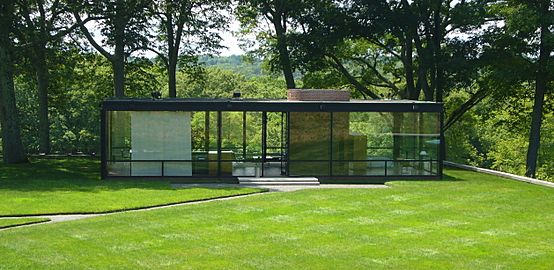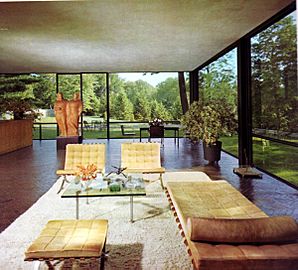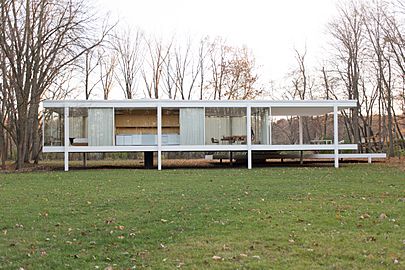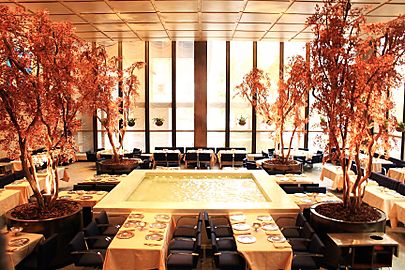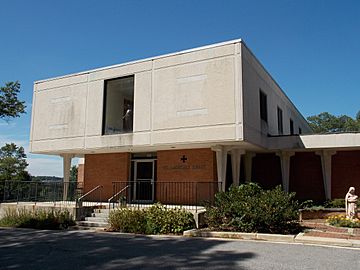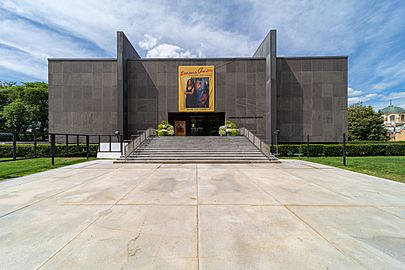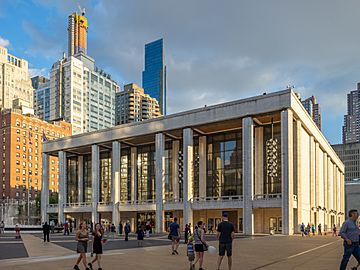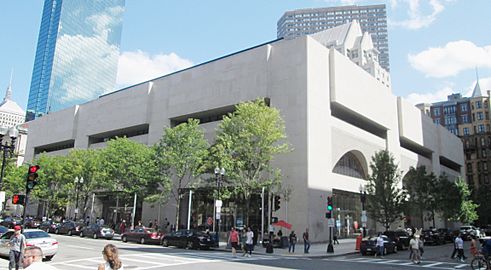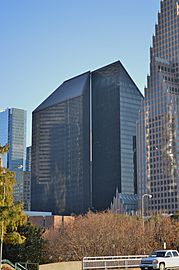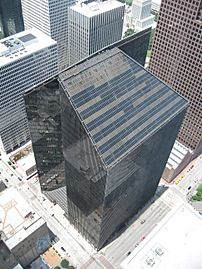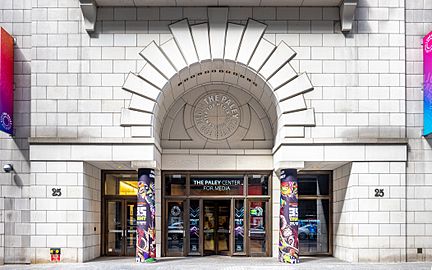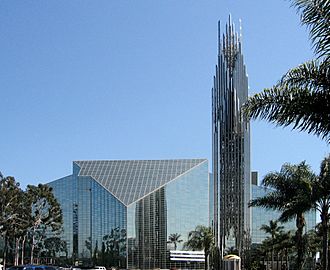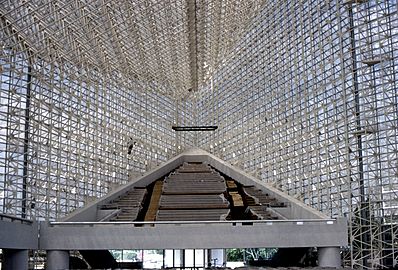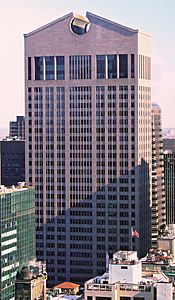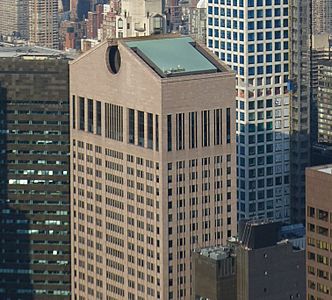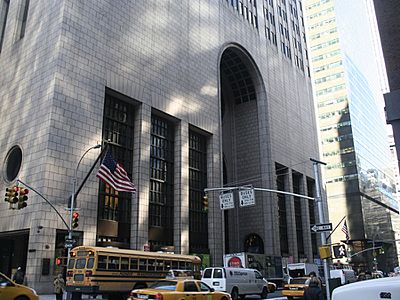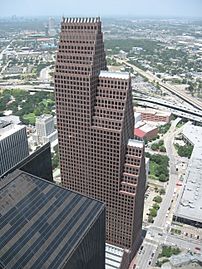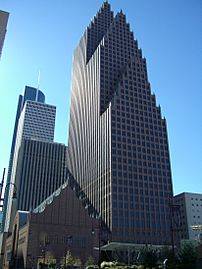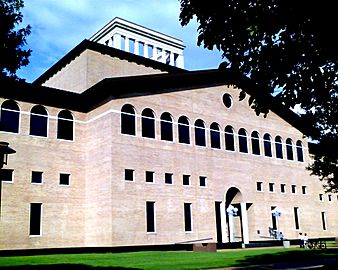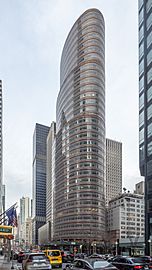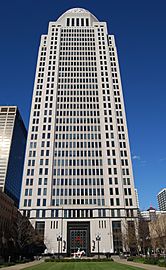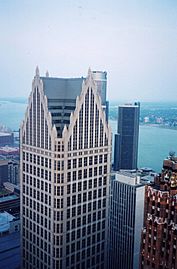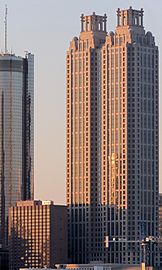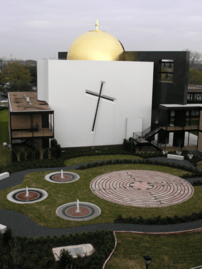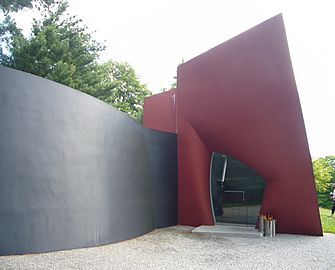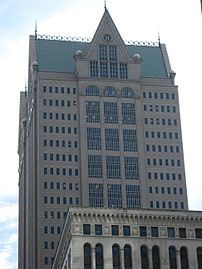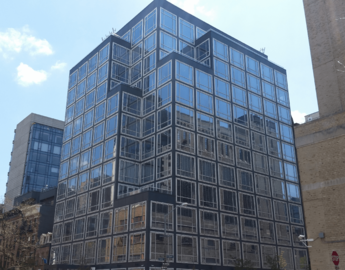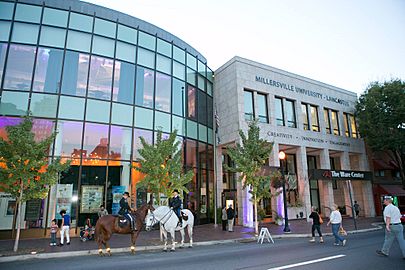Philip Johnson facts for kids
Quick facts for kids
Philip Johnson
|
|
|---|---|
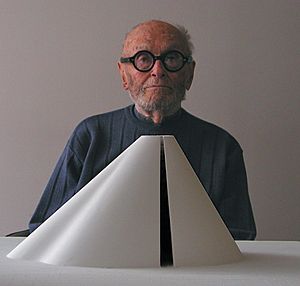
Johnson aged 95, with a model of a privately commissioned sculpture (2002)
|
|
| Born |
Philip Cortelyou Johnson
July 8, 1906 Cleveland, Ohio, U.S.
|
| Died | January 25, 2005 (aged 98) New Canaan, Connecticut, U.S.
|
| Alma mater | Harvard Graduate School of Design |
| Occupation | Architect |
| Awards | Pritzker Prize (1979) AIA Gold Medal (1978) |
| Buildings | Glass House, Seagram Building's 2 restaurants, 550 Madison Avenue, IDS Tower, PPG Place, Crystal Cathedral |
Philip Cortelyou Johnson (July 8, 1906 – January 25, 2005) was an American architect best known for his works of modern and postmodern architecture. Among his best-known designs are his modernist Glass House in New Canaan, Connecticut; the postmodern 550 Madison Avenue in New York, designed for AT&T; 190 South La Salle Street in Chicago; the Sculpture Garden of the Museum of Modern Art; and the Pre-Columbian Pavilion at Dumbarton Oaks. In his obituary in 2005, The New York Times wrote that his works "were widely considered among the architectural masterpieces of the 20th century."
In 1930, Johnson became the first director of the architecture department of the Museum of Modern Art in New York. There he arranged for visits by Walter Gropius and Le Corbusier and negotiated the first American commission for Mies van der Rohe, when he fled Nazi Germany. In 1932, he organized the first exhibition on modern architecture at the Museum of Modern Art.
In 1934, Johnson resigned his position at the museum, and, as the New York Times reported in his obituary, "took a bizarre and, he later conceded, deeply mistaken detour into right-wing politics, suspending his career to work on behalf of Gov. Huey P. Long of Louisiana and later the radio priest Father Charles Coughlin, and expressing more than passing admiration for Hitler." In 1941, as the war approached, Johnson abruptly quit Coughlin's newspaper and journalism. He was investigated by the FBI, and was eventually cleared for military service. Years later he would refer to these activities as "the stupidest thing I ever did [which] I never can atone for".
1978, he was awarded an American Institute of Architects Gold Medal and in 1979 the first Pritzker Architecture Prize. Today his skyscrapers are prominent features in the skylines of New York, Houston, Chicago, Detroit, Minneapolis, Pittsburgh, Atlanta, Madrid, and other cities.
Contents
Early life and career
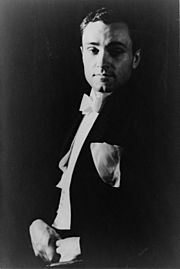
Johnson was born in Cleveland, Ohio, on July 8, 1906, the son of a lawyer, Homer Hosea Johnson (1862–1960), and the former Louisa Osborn Pope (1869–1957), a niece of Alfred Atmore Pope and a first cousin of Theodate Pope Riddle. He had an older sister, Jeannette, and a younger sister, Theodate. He was descended from the Jansen family of New Amsterdam, and included among his ancestors the Huguenot Jacques Cortelyou, who laid out the first town plan of New Amsterdam for Peter Stuyvesant. He grew up in New London, Ohio and attended the Hackley School, in Tarrytown, New York, and then studied as an undergraduate at Harvard University where he focused on learning Greek, philology, history and philosophy, particularly the work of the Pre-Socratic philosophers.
Upon completing his studies in 1927, he made a series of trips to Europe, particularly Germany, where his family had a summer house. He visited the landmarks of classical and Gothic architecture, and joined Henry-Russell Hitchcock, a prominent architectural historian, who was introducing Americans to the work of Le Corbusier, Walter Gropius, and other modernists. In 1928, he met German architect Ludwig Mies van der Rohe, who was at the time designing the German Pavilion for the 1929 Barcelona International Exposition. The meeting formed the basis for a lifelong relationship of both collaboration and competition.
Johnson had a substantial fortune, largely stock given to him by his father. With this fortune, in 1930 he financed the new architecture department of the Museum of Modern Art in New York, and in 1932 he was named its curator. As curator he arranged for American visits by Gropius and Le Corbusier, and negotiated the first American commission for Mies van der Rohe. In 1932, working with Hitchcock and Alfred H. Barr, Jr., he organized the first exhibition on Modern architecture at the Museum of Modern Art. The show and their simultaneously published book International Style: Modern Architecture Since 1922, published in 1932, played a seminal role in introducing modern architecture to the American public. When the rise of the Nazis in Germany forced the modernists Marcel Breuer and Mies van der Rohe to leave Germany, Johnson helped arrange for them to come to work in the United States.
Politics and journalism
In December 1934, Johnson abruptly left the Museum of Modern Art and began pursuing a career in journalism and politics. In 1935, Johnson became a correspondent for "Social Justice", the newspaper of the radical-populist and anti-Semitic Father Charles Coughlin. Johnson traveled to Germany and Poland as a correspondent, where he wrote admiringly about the Nazis.
Sponsored by the German government, he traveled on a press tour which covered the invasion of Poland in 1939.
Architecture school and Army service
In 1941, at the age of 35, Johnson abandoned politics and journalism and enrolled in the Harvard Graduate School of Design, where he studied with Marcel Breuer and Walter Gropius, who had recently fled from Nazi Germany. In 1941, Johnson designed and built his first building, a house at 9 Ash Street in Cambridge, Massachusetts. The house, strongly influenced by Mies van der Rohe, has a wall around the lot which merges with the structure. It was used by Johnson to host social events and was eventually submitted as his graduate thesis; he sold the house after the war, and it was purchased by Harvard in 2010 and restored by 2016.
In 1942, while still a student of the architecture school, Johnson tried to enlist with Naval Intelligence, and then for a federal job, but was rejected both times. In 1943, after his graduation from Harvard, he was drafted to the Army and was sent to Fort Ritchie, Maryland, to interrogate German prisoners of war. He was investigated by the FBI for his involvement with the German government, Coughlin and Lawrence Dennis, an American fascist economist, and was cleared for continued military service. After the trial of Dennis and his collaborators, Johnson was relieved of his interrogation duties and transferred to Fort Belvoir, Virginia, where he spent the rest of his military service doing routine duties.
Early Modernist period (1946–1960)
-
The Glass House (1949)
-
Interior of the Glass House (1949)
-
Farnsworth House by Mies (designed 1945–7) for comparison
In 1946, after he completed his military service, Johnson returned to the Museum of Modern Art as a curator and writer. At the same time, he began working to establish his architectural practice. He built a small house, influenced by the work of Mies, in Saaponack, Long Island. In 1947, he published the first monograph in English on the architecture of Mies.
In 1947, he curated the first exhibition of modern architecture of the Museum of Modern Art including a model of the glass Farnsworth House of Mies.
In 1949 he began building a new residence, the Glass House in New Canaan, Connecticut, that was completed in 1949. It was clearly influenced by Farnsworth House of Mies, an influence which Johnson never denied, but looked quite different.
The Glass House is a 56-foot by 32-foot glass rectangle, sited at the edge of a crest on Johnson's estate overlooking a pond. The building's sides are glass and charcoal-painted steel; the floor, of brick, is not flush with the ground but sits 10 inches above. The interior is an open space divided by low walnut cabinets; a brick cylinder contains the bathroom and is the only object to reach floor to ceiling. The New York Times described it in 2005 as "one of the 20th century's greatest residential structures. "Like all of Johnson's early work, it was inspired by Mies, but its pure symmetry, dark colors and closeness to the earth marked it as a personal statement; calm and ordered rather than sleek and brittle."
Johnson continued to add to the Glass House estate during each period of his career. He added a small pavilion with columns by the lake in 1963, an art gallery set into a hillside in 1965, a postmodern sculpture gallery with a glass roof in 1970; a castle-like library with a rounded tower in 1980; and a concrete block tower dedicated to his friend Lincoln Kirstein, the founder of the New York City Ballet; a chain-link "ghost house" dedicated to Frank Gehry.
After completing the Glass House, he completed two more houses in New Canaan in a style similar to the Glass House; the Hodgson House (1951) and the Wiley House (1953). In New York City, He designed two major modernist additions to the Museum of Modern Art; a new annex, and, to complement it, the Abby Aldrich Rockefeller Sculpture Garden (1953)
In 1954–56, he made the pro bono design for Congregation Kneses Tifereth Israel, a synagogue for a conservative Jewish congregation in Port Chester, New York. It had a simple interior and a ceiling of curving plaster panels.
Johnson joined Mies van der Rohe as the architect of record (Mies did not have NY license) for the 39-story Seagram Building (1956). Johnson was pivotal in steering the commission towards Mies by working with Phyllis Lambert, the daughter of the CEO of Seagram. The commission resulted in the iconic bronze-and-glass tower on Park Avenue. The building was designed by Mies, and the interiors of the Four Seasons and Brasserie restaurants (later redesigned), as well as office furniture were designed by Johnson. In December 1955, the city of New York denied an architect's permit to Mies. He moved back to Chicago and put Johnson fully in charge of construction. Mies returned in late 1956 and finished the building.
In 1989, the New York City Landmarks Preservation Commission designated the Seagram's exterior, lobby, and The Four Seasons Restaurant as official city landmarks. In 2006, the building was added to the National Register of Historic Places.
Late Modernism (1960–1980)
-
The David Koch Theater at Lincoln Center in New York City (completed 1964)
Throughout the 1960s, Johnson continued to create in the vocabulary of the modernist style, designing geometrical theatres, a monastery, art galleries and gardens. The Munson-Williams-Proctor Arts Institute (1960) is a good example of his work in the period; it is supported by eight external ferro-concrete piers, or two on each side. The exterior structural members are clad in bronze and "black" Canadian granite. The windowless cube is set above the office areas, which recessed in a dry moat, giving a "floating" effect. A model of the building was exhibited in the United States Pavilion at the Brussels' World's Fair of 1958,as an example of the new trends in American architecture. It was listed on the National Register of Historic Places in 2010.
Another major project of the period was the Atrium of the David H. Koch Theater (formerly the New York State Theatre, the home of the New York City Ballet, at Lincoln Center in New York.
-
The Johnson Building at Boston Public Library, Boston, Massachusetts (1972) after its 2016 renovation
-
Pennzoil Place in Houston, Texas (1970–1976)
In 1967, Johnson entered a new phase of his career, founding a partnership with architect John Burgee. He began to design office building complexes for large corporations. The most prominent of these was Pennzoil Place (1970–76) in Houston, Texas. The two towers of Pennzoil Place have sloping roofs covering the top seven floors and are trapezoidal in form, planned to create two large triangual areas on the site, which are occupied with glass-covered lobbies designed like greenhouses. This idea was widely copied in skyscrapers in other cities.
The new building of the Boston Public Library (1972), known as the Johnson building, adjoins the original Boston library built in the 19th century by the celebrated firm of McKim, Mead & White. Johnson harmonised his building with the original landmark by using similar proportions and the same pink Milford granite.
-
The Fort Worth Water Gardens, in Fort Worth, Texas (1974)
-
The spiral chapel in Thanks-Giving Square in Dallas,Texas (1977)
In the late 1970s, Johnson combined architecture and landscape architecture to create two imaginative civic gardens. The Fort Worth Water Gardens opened in 1974, is an urban landscape where visitors experience water in distinct ways. The gardens cover 4.3-acres (1.7 hectare), and comprise three very different kinds of water features; One offers a quiet meditation pool, surrounded with cypress trees and high walls, with a thin sheet of water cascading downward to the pool, making the sound of a rain shower. The second pool is an aerating pool with multiple illuminated spray fountains, beneath a grove of oak trees. The third fountain is the Active Pool, which challenges fit visitors to walk down 38 feet (12 meters) to the pool at the bottom, with water cascading all around them.
In 1977, Johnson completed a much quieter garden in Dallas, Thanks-Giving Square It features a non-denominational chapel in a spiral form, a meditation garden and cascading fountains, tucked between buildings in the center of the city.
Postmodern period (1980–1990)
-
The Crystal Cathedral (finished 1980)
In 1980, Johnson and Burgee completed a cathedral in a dramatic new style: the Crystal Cathedral in Garden Grove, California, is a soaring glass megachurch originally built for the Reverend Robert H. Schuller. The interior can seat 2,248 persons. It takes the form of a four-pointed star, with free-standing balconies in three points and the chancel in the fourth. The cathedral is covered with more than ten thousand rectangular pieces of glass. The Glass panels are not bolted, but glued to the structure, with a silicon based glue, to give it greater ability to resist Southern California earthquakes. Johnson and Burgee designed it to withstand an earthquake of magnitude 8.0. The tower was added in 1990.
The cathedral quickly became a Southern California landmark, but its costs helped drive the church into debt. When the church declared bankruptcy in 2012, it was purchased by the Roman Catholic Diocese of Orange and became the Roman Catholic cathedral for Orange County.
Working with John Burgee, Johnson did not confine himself to a single style, and was comfortable mixing elements of modernism and postmodernism. For the Cleveland Play House, he built a romanesque brick structure; His skyscrapers in the 1980s were clad in granite and marble, and usually had some feature borrowed from historic architecture. In New York he designed the Museum of Television and Radio, (now the Paley Center for Media) (1991).
-
550 Madison Avenue (1982)
-
Top of 550 Madison Avenue
-
Window of 550 Madison Avenue
-
Entrance of 550 Madison Avenue
In 1982, working in collaboration with John Burgee, he finished one of his most famous buildings, 550 Madison Avenue, (first known as AT&T Building, then the Sony building before taking its present name). Built between 1978 and 1982, it is a skyscraper with an eight-story high arched entry and a split pediment at the top which resembles an enormous piece of 18th-century Chippendale furniture. It was not the first work of Postmodern architecture, as Robert Venturi and Frank Gehry had already built smaller scale postmodern buildings, and Michael Graves had completed the Portland Building (1980–82) in Portland, Oregon, two years earlier; But the building's Manhattan location, size and originality made it the most famous and recognizable example of postmodern architecture. It was designated a city landmark by the New York City Landmarks Preservation Commission in 2018.
-
TC Energy Center (Formerly Bank of America Center) in Houston, Texas (1983)
-
The TC Energy Center, Houston (1983)
-
PPG Place, Pittsburgh, (1984)
Between 1979 and 1984, Johnson and Burgee built PPG Place the postmodern headquarters of the Pittsburgh Plate Glass Company. It is a complex of six buildings within three city blocks, covering five and a half acres. The centerpiece is the forty-story tower, One PPG Place,which has a crown of spires at the corners which suggest the neogothic tower of the Houses of Parliament in London. During the 1980s Johnson and Burgee completed a series of other notable postmodern landmarks. The TC Energy Center (Formerly Republic Bank Center, later, Bank of America Center), in Houston (1983), was the first postmodern skyscraper in the Houston skyline. Fifty-six Stories high, it has two setbacks creating what appear to be three different buildings, one against the other. The Three triangular gables were inspired by Flemish Renaissance architecture. The interior and exterior are covered with rough-textured red granite, which also covers the surrounding sidewalks.
-
The elliptical Lipstick Building in Manhattan, (1986)
-
The concrete tower and cupola of 400 West Market in Louisville, Kentucky (1993)
The new building for the Hines College of Architecture (1985) of the University of Houston paid homage to forms drawn from earlier periods of architectural history, using modern materials, construction methods and scale. The facade of the Hines building resembles, on a larger scale, the neoclassic facades of the French architect Claude Nicolas Ledoux.
400 West Market (1993), in Louisville, Kentucky is a thirty-five story office tower built of reinforced concrete rather than the typical steel. It is topped by a concrete cupola, a vestige of the building's original owner and builder, Capital Holding.
In 1986, Johnson and Burgee had moved their offices into one of their new buildings, the Lipstick Building, the popular name of the elliptical skyscraper they built at 885 Third Avenue in New York, and given its nickname because of its resemblance to the color and shape of a stick of lipstick. A feud was beginning between the two architects, with Burgee demanding greater recognition.
As their business flourished and number of clients grew, the feud between Burgee and Johnson continued to grow. In 1988, the firm's name was changed to John Burgee Architects with Johnson as the "design consultant". In 1991, Johnson responded by establishing his own firm. The feud ended badly for Burgee; he was saddled with all of the debts of the firm, while Johnson no longer had any responsibility. Burgees was eventually forced to declare bankruptcy, and to retire, while Johnson continued to get commissions.
Later career and buildings (1991–2005)
-
One Detroit Center in Detroit, Michigan (1991–1993)
-
191 Peachtree Tower in Atlanta (1991)
-
"Da Monsta" entry pavilion for the Glass House in New Canaan, Connecticut (1995)
-
Gate of Europe towers in Madrid, Spain (1989–96)
-
190 South LaSalle in Chicago, Illinois (1987)
After four years as a solo practitioner, Johnson invited Alan Ritchie to join him as a partner. Ritchie had been a partner for many years in the Johnson-Burgee office and was the partner-in-charge of the AT&T building and the 190 South LaSalle office building, a skyscraper designed as an homage to the demolished Masonic Temple of Chicago. In 1994, they formed the new practice of Philip Johnson-Alan Ritchie Architects. During the next ten years, they worked closely together and explored new directions in architecture, designing buildings as sculptural objects.
The Gate of Europe in Madrid (1989 - 1996) was originally a collaboration with Burgee, and one of his rare works in Europe. It features two office buildings leaning toward each other, the first example of this style, which spread to America. The towers are twenty-six stories each, and both lean by 15 degrees from vertical.
191 Peachtree Tower in Atlanta was a project begun with Burgee. It is composed of two fifty-story towers joined, and crowned with two classical pavilions.
The Comerica Tower (1991-1993) was also begun with Burgee. Like their earlier Postmodern works, it featured elements borrowed from historical architecture, particularly the triangular gables, borrowed from Renaissance Flemish architecture. It is the second tallest building in the state of Michigan.
The Chapel of St. Basil at the University of St. Thomas in Houston, Texas (1992) is notable late work. The design includes a domed chapel, a campanile, and a mediation garden, a labyrinth. Its structure is combination of the basic forms; a cube, a sphere, and a plane. The cube contains the worship area, beneath a semi-sphere, which is presented as the symbolic opening to heaven. The vertical rectangular granite plane divides the church and opens the chapel to light. During daytime the interior is lit entirely with natural light.
In 1995, Johnson added a postmodern element to his own residence, the Glass House. This was a new entry pavilion in a sculptural form, which he called the "Monsta", or "Monster".
Other late works include the Cathedral of Hope in Dallas, the Habitable Sculpture (a 26-story apartment tower in lower Manhattan); The Children's Museum in Guadalajara, Mexico, and The Chrysler Center in Detroit.
-
The Urban Glass House condominiums in New York (2006)
The Urban Glass House in lower Manhattan was one of last designs with Alan Ritchie, and was not completed after Johnson's death. It is a condominium building in lower Manhattan whose form was inspired by Johnson's most famous early work, the Glass House in New Canaan, Connecticut.
The final building he designed with Richie was the Pennsylvania Academy of Music building in Lancaster, Pennsylvania, which was completed in 2008, three years after his death.
Honors
In 1978, Johnson was awarded an American Institute of Architects Gold Medal. In 1979, he became the first recipient of the Pritzker Architecture Prize the most prestigious international architectural award.
In 1991, Johnson received the Golden Plate Award of the American Academy of Achievement.
Personal life
Johnson was gay. He came out publicly in 1993, and was regarded as "the best-known openly gay architect in America".
In 1934, Philip Johnson began his first serious relationship with Jimmie Daniels, a cabaret singer. The relationship lasted only one year.
Johnson died in his sleep at his Glass House retreat on January 25, 2005, at the age of ninety-eight. His partner of 45 years, David Whitney, died later that year at age 66.
Johnson was among the public figures at the core of the effort to save Olana, the home of Frederic Edwin Church, before it was dedicated a National Historic Landmark in 1965 and subsequently became a New York State Historic Site.
In his will Johnson left his residential compound to the National Trust for Historic Preservation. It is now open to the public.
Art collection and archives
As an art collector Johnson had an eclectic eye. He supported avant-garde movements and young artists often before they became widely known. His collection of American art was strong in Abstract expressionism, Pop Art, Minimalism, Neo-Dada, Color Field, Lyrical Abstraction, and Neo-Expressionism and he often donated important works from his collection to institutions like MoMA, and other important private museums and University collections like the Norton Simon Museum, the Sheldon Museum of Art and the Iris & B. Gerald Cantor Center for Visual Arts at Stanford University among many others.
Johnson's publicly held archive, including architectural drawings, project records, and other papers up until 1964 are held by the Drawings and Archives Department of Avery Architectural and Fine Arts Library at Columbia University, the Getty, and the Museum of Modern Art.
Quotations
- "I got everything from someone. Nobody can be original. As Mies van der Rohe said, 'I don't want to be original. I want to be good.'"
- "Don't build a glass house if you're worried about saving money on heating."
- "Everybody should design their own home. I'm against architects designing homes. How do I know that you want to live in a picture-window Colonial? It's silly, but you might want to. Who am I to say?"
- "Architecture is the arrangement of space for excitement".
- "Storms in this house (The Glass House) are horrendous but thrilling. Glass shatters. Danger is one of the greatest things to use in architecture."
- "A room is only as good as you feel when you're in it".
- "Merely that a building works is not sufficient."
See also
 In Spanish: Philip Johnson para niños
In Spanish: Philip Johnson para niños


